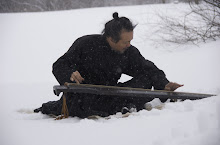[兩卦流轉 古琴因緣]
~~吳浸陽師祖所斲六十四卦琴
袁中平

吳浸陽先生像

需卦琴陽面

需卦琴陰面

鼎卦琴陰面

鼎卦琴陽面
此二琴(如圖所見)是師祖 吳浸陽先生所斲於一九二五年間。當時他得到史量才先生支持,於上海一帶縣城中,覓得大量明代屋樑等優良木材,在申報館五樓琴室,設計監製了六十四床古琴,以易經六十四卦分別命名。
一九七三年夏,此二琴由 吳兆基恩師獲贈於其表舅母熊淑婉女史於上海。熊女史亦是吳浸陽之弟子,同年先生將其中一[鼎卦琴]贈於南京胞弟吳兆奇先生收藏至今,自珍藏[需卦琴]至一九九零年夏贈與余,其餘六十二床至今不知散佚何處。
浸陽師祖字觀月號純白。少年時出家青城山為道士,四川洪都人,長往於蘇州、上海、杭州一帶。民國八、九年間,供職於蘇州鹽公堂。堂主葉璋伯字希明,杭州人亦善操琴,需卦琴內刻文是其所題。葉先生亦是一九一九年八月怡園琴會之主持人,浸陽先生琴藝師承未詳,風格瀟洒靈活,兼具蜀、熟兩派之長。辛亥革命以後第一次全國性琴會,在一九二一年五月於上海晨風廬召開,由周夢坡先生主持。兆基恩師由其父吳蘭蓀領往,遇浸陽先生,獨衷其所奏漁歌、瀟湘,幾經周折得拜於門下,二年間恩師習得是二曲。三十年代初浸陽先生往香港未還,五十年代末歿於香港,身後蕭條。
二零零二年九月蘇州紀念吳蘭蓀一百二十誕辰音樂會中,余得緣見兆奇先生所藏之[鼎卦琴](如圖所見) 。琴聲沉洪清越、和潤含遠,與余所藏[需卦琴]一式一般,體樸形素,絕無近世作態氣息。
觀此二琴同為師祖所親斲,又兼傳其弟子,而[需卦琴]再傳與余,本門所重。薪燼火傳,元音新聲,意義深遠。[需卦琴]恩師曾戲稱為[扣子琴],問其故? 恩師言及,得琴時發現琴徽已失,當時無處得覓金玉螺鈿,乃親以衣扣磨而代之,至今仍在琴上完好。感兩代手澤融於一琴,觸物思往,念其間斯人、斯事,令人浩嘆。
二琴斲成至今已八十寒暑,幸均無恙,分處東西兩地,同響中外人間。特記此二琴之流轉因緣,以告諸同道。
癸未七月作於紐約
The Wanderings of Two I-Ching Guas
– A Story About Two Qins
The two qins were made in 1925, by the founder of my qin school, Wu Jinyang. At the time, he received support from Shi Liangcai and obtained a large number of Ming dynasty wood around cities near Shanghai. In a qin studio situated on the fifth floor of the Shen newspaper agency, Wu Jinyang designed and produced sixty-four qins, each named after a gua (divination diagram) from the Yijing, the Book of Changes.
In the summer of 1973, these two qins were given to my teacher Wu Zhaoji’s maternal aunt, Xiong Shuwan in Shanghai. Ms. Xiong was also a disciple of Wu Jinyang. In the same year, if I remember correctly, Wu Zhaoji gave the Zhen gua (divination diagram named Zhen) qin in the collection to his brother in Nanjing, Mr. Wu Zhaoqi. That qin remains in his collection to this day. Mr. Wu Zhaoji collected the Xu gua qin himself until the summer of 1990, when he bestowed it to me. As for the other sixty-two qins in the Yijing collection, they are scattered and lost, leaving no traces of where they may be today.
Wu Jinyang or Master Jinyang, also named Guanyue and Chunbai, left home to become a Daoist priest in his teenage years at Qingcheng Mountain. He was born in Hongdu, Sichuan and lived many years in Suzhou, Shanghai and Hangzhou. Around 1919-1920, he worked in a salt production company in Suzhou. The owner of this company was named Ye Zhangbo, also known as Ximing. Ye Zhangbo was born in Hangzhou and was a well known qin player. The inscriptions in the Xu gua qin was carved by him. In August 1919, he hosted the qin gathering at Yi Garden, Suzhou.
We do not know who Master Jinyang’s pedagogical ancestors were, but his style was elegant and lively. He possessed the best qualities of the Sichuan and Yushan schools. After the revolution of 1911, the first national qin gathering took place in Chen Feng Lu (The Morning Breeze Studio) of Shanghai during the month of May in the year 1921. The host was Mr. Zhou Mengpo. My teacher, Wu Zhaoji, was taken to that gathering by his father, Wu Lansun. There, he encountered Master Jinyang. Wu Zhaoji took an immediate liking to Master Jinyang’s interpretations of Yu Ge and Xiao Xiang Shui Yun among the sea of performers. After some difficulty in persuading Master Jinyang to become his teacher, Wu Zhaoji secretly memorized Master Jinyang’s portrayal of Yu Ge. He performed this portrayal when Master Jinyang came to visit the family. Master Jinyang was deeply touched. From that moment on, Master Jinyang became Wu Zhaoji’s teacher. In the next two years, when Wu Zhaoji was 16 and 17 years old, he learned Yu Ge and Xiao Xiang Shui Yun.
In the 1930’s, Master Jinyang went to Hong Kong and never returned to China. In the late 1950’s, he passed away, poorly and lonely.
In September 2002, Suzhou held a memorial qin conference for Wu Lansun. It was then when I was fortunate enough to view Wu Zhaoqi’s Zhen gua qin. I took these pictures when two of Wu Zhaoqi’s students visited me to ask about the interpretation of Yang Chun. The sound of the Zhen gua qin is bright but pure, gentle but distant. In comparison to the Xu gua qin in my collection, aside from the shape being the same, even the tonality and timbre are similar. Both qins are larger than normal. They are also very plain. They certainly contain none of the pretentious aura of some contemporary qins.
These two qins are both created by Master Jinyang and henceforth, were inherited by his students. Xu gua qin was further passed down three generations by his student to me. In our school, we highly value these qins as they represent the school’s passage down generation after generation. Wu Zhaoji once joked that the Xu gua qin is really a “qin of buttons”. I questioned him about this correlation and he told me that the Xu gua qin lost all of its huis (markers) when he received it. So, he used buttons for the thirteen huis, after filing them down and gluing them onto the qin. To this day, the buttons still sits firmly on the qin.
As the qin and the buttons survive, the Xu gua qin is representative of two different people who belonged to two different generations. When I touch the qin, I think about its history, its relationships and its events. It truly makes one breathe a long sigh. It has been eighty years since the qin’s creation. The comforting fact is that the qin remains in good shape. It has lived in the East and the West, transmitted its music in China and America. Here, in this short essay, I share to our qin ren about the story of the Yijing qins.
By Zhong Daoren, Yuan Jung-ping. August 2003, New York City.






沒有留言:
張貼留言